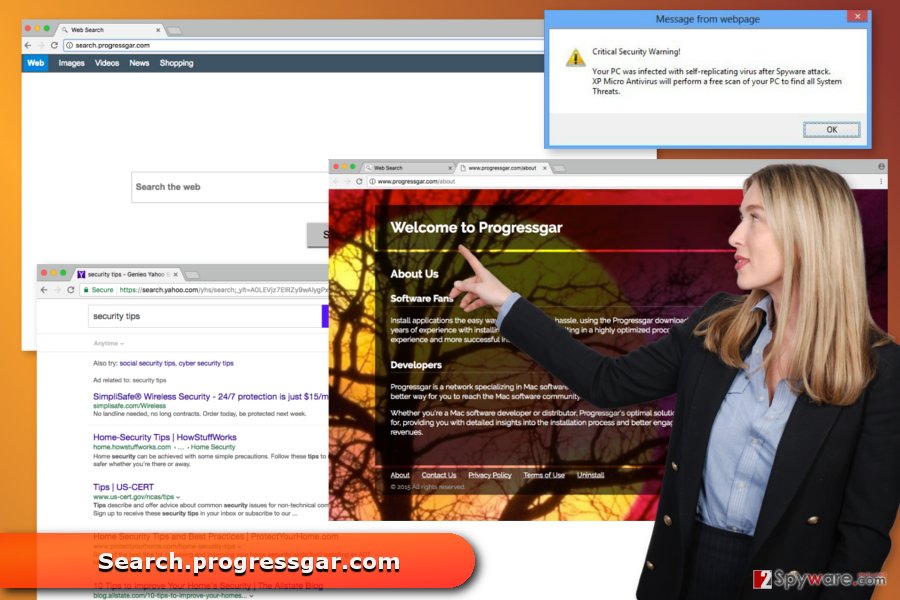Search.progressgar.com virus (Free Guide) - Tutorial
Search.progressgar.com virus Removal Guide
What is Search.progressgar.com virus?
Search.progressgar.com might hijack web browsers on Mac OS X

Search.progressgar.com is a dubious search engine identical to search.jangoram.com and search.societycake.com. This potentially unwanted program (PUP) spreads in software bundles and hijacks web browsers installed on Mac computers. [1]
After the Search.progressgar.com hijack, when users open Safari, Chrome or Firefox web browsers, they find changed homepage and default search engine. Nevertheless, this new search tool looks like an ordinary search engine that allows searching for an information in five different categories, such as the web, images, videos, news, and shopping; it’s not worth relying on.
The Search.progressgar.com virus redirects search queries to Yahoo search. Therefore, developers profit from Yahoo affiliates’ program. This way of making incomes is absolutely legitimate. However, the browser hijacker might display intrusive ads and seek user’s click in an aggressive way.
The virus might display numerous ads on your favorite websites. They might cover necessary content and make browsing the web annoying. However, if you click on such content, you might be redirected to the potentially dangerous websites.
You should not ignore Search.progressgar.com redirect issues and avoid clicking ads, pop-ups or banners no matter how interesting they might look to you. Instead of redirecting you to the shopping website where you can accept your discount or another offer, the hijacker might redirect to a misleading or fake site. Here you might be tricked into revealing personal information or installing useless software.
These undesired changes and activities on your browser should not be tolerated. As you can see, you can be easily get infected with some cyber infection[2] by browsing through suspicious websites. Hence, you should scan the computer with reputable security software and get rid of the hijacker. We recommend FortectIntego for Search.progressgar.com removal.
Keep in mind that keeping the hijacker on the browser might lead only to the increasing amount of commercial content. It might happen due to the hijacker’s ability to collect information about the users. Based on the aggregated data, it might deliver targeted ads.
According to the Progressgar’s Privacy Policy, it might collect technical information about your browser, operating system and some of the non-personally identifiable information, such as your location, installed applications and browsing-related information. Therefore, if you do not want to be spied on by an unknown company, you should remove Search.progressgar.com right now.

Everything you need to know about hijacker’s distribution strategy
Once you click “About” section on the Search.progressgar.com main page, you will be redirected to progressgar.com website. Here you can learn that Progressgar platform helps to spread programs for developers and distributors. Therefore, there are no doubts that people standing behind a browser hijacker specialize in bundling.
The hijacker is also promoted and spread using this strategy. It allows adding PUP as an optional component in freeware or shareware package. Such additional entries are hidden under Recommended/Standard settings, so if you install freeware using them, you give indirect permission to install them together with the primary program.
In order to avoid installation of undesired apps, you should:
- choose reliable download websites,
- use Advanced/Custom installation settings,
- monitor the process and unmark pre-selected entries,
- read the Privacy Policy and EULA.
This method helps to spread the hijacker not only in the U.S. but all over the world, including European countries, China[3] and other parts of the world.
Eliminate Search.progressgar.com virus from the system by following these steps
If you are looking for manual Search.progressgar.com removal instructions, you can find them below the article. Follow each of the steps carefully in order to eliminate suspicious components from the system and each of the web browsers. If you miss something, you might experience re-hijack.
In order to speed up the procedure, you can remove Search.progressgar.com using security software. You have to obtain reliable anti-malware/anti-spyware and run a full system scan with an updated tool.
You may remove virus damage with a help of FortectIntego. SpyHunter 5Combo Cleaner and Malwarebytes are recommended to detect potentially unwanted programs and viruses with all their files and registry entries that are related to them.
Getting rid of Search.progressgar.com virus. Follow these steps
Uninstall from Windows
Instructions for Windows 10/8 machines:
- Enter Control Panel into Windows search box and hit Enter or click on the search result.
- Under Programs, select Uninstall a program.

- From the list, find the entry of the suspicious program.
- Right-click on the application and select Uninstall.
- If User Account Control shows up, click Yes.
- Wait till uninstallation process is complete and click OK.

If you are Windows 7/XP user, proceed with the following instructions:
- Click on Windows Start > Control Panel located on the right pane (if you are Windows XP user, click on Add/Remove Programs).
- In Control Panel, select Programs > Uninstall a program.

- Pick the unwanted application by clicking on it once.
- At the top, click Uninstall/Change.
- In the confirmation prompt, pick Yes.
- Click OK once the removal process is finished.
Delete from macOS
You should look up for the suspicious Applications that may have sneaked to your PC. They might be responsible for the hijacked browser.
Remove items from Applications folder:
- From the menu bar, select Go > Applications.
- In the Applications folder, look for all related entries.
- Click on the app and drag it to Trash (or right-click and pick Move to Trash)

To fully remove an unwanted app, you need to access Application Support, LaunchAgents, and LaunchDaemons folders and delete relevant files:
- Select Go > Go to Folder.
- Enter /Library/Application Support and click Go or press Enter.
- In the Application Support folder, look for any dubious entries and then delete them.
- Now enter /Library/LaunchAgents and /Library/LaunchDaemons folders the same way and terminate all the related .plist files.

Remove from Microsoft Edge
Delete unwanted extensions from MS Edge:
- Select Menu (three horizontal dots at the top-right of the browser window) and pick Extensions.
- From the list, pick the extension and click on the Gear icon.
- Click on Uninstall at the bottom.

Clear cookies and other browser data:
- Click on the Menu (three horizontal dots at the top-right of the browser window) and select Privacy & security.
- Under Clear browsing data, pick Choose what to clear.
- Select everything (apart from passwords, although you might want to include Media licenses as well, if applicable) and click on Clear.

Restore new tab and homepage settings:
- Click the menu icon and choose Settings.
- Then find On startup section.
- Click Disable if you found any suspicious domain.
Reset MS Edge if the above steps did not work:
- Press on Ctrl + Shift + Esc to open Task Manager.
- Click on More details arrow at the bottom of the window.
- Select Details tab.
- Now scroll down and locate every entry with Microsoft Edge name in it. Right-click on each of them and select End Task to stop MS Edge from running.

If this solution failed to help you, you need to use an advanced Edge reset method. Note that you need to backup your data before proceeding.
- Find the following folder on your computer: C:\\Users\\%username%\\AppData\\Local\\Packages\\Microsoft.MicrosoftEdge_8wekyb3d8bbwe.
- Press Ctrl + A on your keyboard to select all folders.
- Right-click on them and pick Delete

- Now right-click on the Start button and pick Windows PowerShell (Admin).
- When the new window opens, copy and paste the following command, and then press Enter:
Get-AppXPackage -AllUsers -Name Microsoft.MicrosoftEdge | Foreach {Add-AppxPackage -DisableDevelopmentMode -Register “$($_.InstallLocation)\\AppXManifest.xml” -Verbose

Instructions for Chromium-based Edge
Delete extensions from MS Edge (Chromium):
- Open Edge and click select Settings > Extensions.
- Delete unwanted extensions by clicking Remove.

Clear cache and site data:
- Click on Menu and go to Settings.
- Select Privacy, search and services.
- Under Clear browsing data, pick Choose what to clear.
- Under Time range, pick All time.
- Select Clear now.

Reset Chromium-based MS Edge:
- Click on Menu and select Settings.
- On the left side, pick Reset settings.
- Select Restore settings to their default values.
- Confirm with Reset.

Remove from Mozilla Firefox (FF)
Open the list of Mozilla Firefox add-ons. If you see suspicious extensions or toolbars installed, remove them ASAP. They might be responsible for keeping Search.progressgar.com on the Mozilla.
Remove dangerous extensions:
- Open Mozilla Firefox browser and click on the Menu (three horizontal lines at the top-right of the window).
- Select Add-ons.
- In here, select unwanted plugin and click Remove.

Reset the homepage:
- Click three horizontal lines at the top right corner to open the menu.
- Choose Options.
- Under Home options, enter your preferred site that will open every time you newly open the Mozilla Firefox.
Clear cookies and site data:
- Click Menu and pick Settings.
- Go to Privacy & Security section.
- Scroll down to locate Cookies and Site Data.
- Click on Clear Data…
- Select Cookies and Site Data, as well as Cached Web Content and press Clear.

Reset Mozilla Firefox
If clearing the browser as explained above did not help, reset Mozilla Firefox:
- Open Mozilla Firefox browser and click the Menu.
- Go to Help and then choose Troubleshooting Information.

- Under Give Firefox a tune up section, click on Refresh Firefox…
- Once the pop-up shows up, confirm the action by pressing on Refresh Firefox.

Remove from Google Chrome
We recommend looking for unknown Chrome extensions. Once you uninstall them, you should reset the browser too.
Delete malicious extensions from Google Chrome:
- Open Google Chrome, click on the Menu (three vertical dots at the top-right corner) and select More tools > Extensions.
- In the newly opened window, you will see all the installed extensions. Uninstall all the suspicious plugins that might be related to the unwanted program by clicking Remove.

Clear cache and web data from Chrome:
- Click on Menu and pick Settings.
- Under Privacy and security, select Clear browsing data.
- Select Browsing history, Cookies and other site data, as well as Cached images and files.
- Click Clear data.

Change your homepage:
- Click menu and choose Settings.
- Look for a suspicious site in the On startup section.
- Click on Open a specific or set of pages and click on three dots to find the Remove option.
Reset Google Chrome:
If the previous methods did not help you, reset Google Chrome to eliminate all the unwanted components:
- Click on Menu and select Settings.
- In the Settings, scroll down and click Advanced.
- Scroll down and locate Reset and clean up section.
- Now click Restore settings to their original defaults.
- Confirm with Reset settings.

Delete from Safari
In order to get rid of Search.progressgar.com from the Safari entirely, you should follow these guidelines:
Remove unwanted extensions from Safari:
- Click Safari > Preferences…
- In the new window, pick Extensions.
- Select the unwanted extension and select Uninstall.

Clear cookies and other website data from Safari:
- Click Safari > Clear History…
- From the drop-down menu under Clear, pick all history.
- Confirm with Clear History.

Reset Safari if the above-mentioned steps did not help you:
- Click Safari > Preferences…
- Go to Advanced tab.
- Tick the Show Develop menu in menu bar.
- From the menu bar, click Develop, and then select Empty Caches.

After uninstalling this potentially unwanted program (PUP) and fixing each of your web browsers, we recommend you to scan your PC system with a reputable anti-spyware. This will help you to get rid of Search.progressgar.com registry traces and will also identify related parasites or possible malware infections on your computer. For that you can use our top-rated malware remover: FortectIntego, SpyHunter 5Combo Cleaner or Malwarebytes.
How to prevent from getting stealing programs
Stream videos without limitations, no matter where you are
There are multiple parties that could find out almost anything about you by checking your online activity. While this is highly unlikely, advertisers and tech companies are constantly tracking you online. The first step to privacy should be a secure browser that focuses on tracker reduction to a minimum.
Even if you employ a secure browser, you will not be able to access websites that are restricted due to local government laws or other reasons. In other words, you may not be able to stream Disney+ or US-based Netflix in some countries. To bypass these restrictions, you can employ a powerful Private Internet Access VPN, which provides dedicated servers for torrenting and streaming, not slowing you down in the process.
Data backups are important – recover your lost files
Ransomware is one of the biggest threats to personal data. Once it is executed on a machine, it launches a sophisticated encryption algorithm that locks all your files, although it does not destroy them. The most common misconception is that anti-malware software can return files to their previous states. This is not true, however, and data remains locked after the malicious payload is deleted.
While regular data backups are the only secure method to recover your files after a ransomware attack, tools such as Data Recovery Pro can also be effective and restore at least some of your lost data.
- ^ Viruses on Mac: What You Need to Know. SecureMac. Security News, Advisories, Reviews and Software for Everything Apple and Mac.
- ^ What viruses should we expect to meet in 2017?. VirusActivity. The blog about recent computer viruses and cyber security.
- ^ Wubingdu. Wubingdu. Chinese website about malware and removal tutorials.























